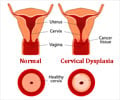Brachytherapy treatment was associated with better cause-specific survival and overall survival in women with cervical cancer, finds a study by researchers at Brigham and Women's Hospital.

The study is published in the September 2013 issue of The International Journal of Radiation Oncology.
The researchers used the Surveillance, Epidemiology, and End Results (SEER) Database to identify 7,359 patients with advanced stage cervical cancer treated with external beam radiation therapy (EBRT) between 1988 and 2009. (The 18 SEER population-based registries cover approximately 28 percent of the US population and include Connecticut, New Jersey, Metropolitan Detroit, Iowa, New Mexico, Hawaii, Seattle, Utah, Alaska, San Francisco-Oakland, San Jose-Monterey, Los Angeles, Greater California, Kentucky, Louisiana, Metropolitan Atlanta, Rural Georgia, and Greater Georgia. The registries collect information about patient and tumor characteristics and first course of cancer-directed treatment.)
Of the 7,359 patients identified, the researchers found that 63 percent of these women received brachytherapy in combination with EBRT, and 37 percent received EBRT alone. Factors associated with higher odds of brachytherapy use included younger age, being married, earlier years of diagnosis, earlier stage and certain SEER regions.
Moreover, brachytherapy usage rate decreased from 83 percent in 1988 to 58 percent in 2009. There was a sharp decline from 43 percent to 23 percent in 2003. The researchers noted that the decline may be related to the decreasing incidence of cervical cancer and increased adoption of alternative treatment techniques, such as intensity modulated radiation therapy (IMRT) and stereotactic body radiation therapy (SBRT).
In terms of patient survival, brachytherapy was associated with a higher four-year cause-specific survival (64.3 percent vs. 51.5 percent) and overall survival (58.2 percent vs. 46.2 percent) compared to EBRT alone. Brachytherapy treatment was also independently associated with better cause-specific survival and overall survival.
Advertisement
Brachytherapy is an important component of treatment that escalates the dose of radiation to the primary tumor while minimizing the dose to critical organs at risk. The standard treatment of locally advanced cervical cancer is EBRT with concurrent chemotherapy, followed by brachytherapy.
Advertisement















